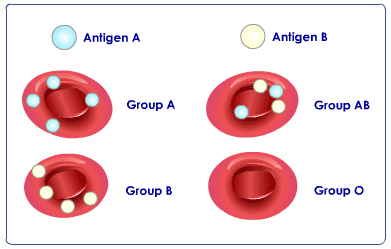| Got from mother | Got from father | Blood Type | Notice |
| A | A | A | |
| A | i | A | A is dominant over i |
| B | B | B | |
| B | i | B | B is dominant over i |
| A | B | AB | No dominance A or B |
| i | i | O | i is recessive |
So, if you have one parent who is type A and one who is type B, it would be possible to get any of the blood types (A, B, AB, or O) if both parents are carrying the i gene (which is recessive). But if one parent is type AB and the other is type O, then the children could only be type A (carrying the recessive i) or type B (also carrying the recessive i). And if both parents are type O, then all children will be type O. As this image shows, A is an antigen like a horn or flag on the blood cell, and so is B. Blood type O means there are no antigens on the cell surface for antibodies to recognize. When you mix antibodies to A with type A blood or type AB blood, it clumps together, but if you mix antibodies to A with type O blood, nothing happens.
Then, there is the Rh factor, which is a dominant gene. If you have one or two copies of it, then you are Rh+. And if you mix antibodies to the Rh factor with blood that is Rh+, it will clump together. A person who is negative for Rh factor cannot receive blood from a person who is positive for it. But a person who is positive can receive either Rh+ or Rh- blood. As we described it in class, you get freaked out if you see an antigen you don't normally see (like an A, a B, or the Rh factor). That is incompatible and could kill the person. But if you normally see an antigen (A, B, Rh factor or all of them), you don't have a problem receiving blood without it.
To illustrate, we first played the Nobel Prize website blood typing game (the discovery of blood types has saved millions of lives and earned a Nobel Prize).
To illustrate, we first played the Nobel Prize website blood typing game (the discovery of blood types has saved millions of lives and earned a Nobel Prize).
First, you need to determine the emergency room patient's blood type. To do this, there are three tubes: one with an antibody for A, one with an antibody for B, and one with an antibody for Rh factor. You add the patient's blood to each tube and see what happens. Either the blood reacts with the antibody, forming a clump in the bottom of the tube, or it doesn't react and the tube remains red throughout the liquid. From these results, you know the patient's blood type. If all three react, the blood type is AB+, if none react, it's O-, if the first and third react, it's A+, and so on. Now that you know the blood type, you can determine which blood bags you could give the patient without endangering them.
 |
| Choosing which blood types the patient could safely receive |
As we learned, you can't give a patient blood that has an antigen their blood doesn't have. They can always receive their own exact blood type, and any type that has fewer antigens than theirs has. So our A+ patient can receive A+, A-, O+, and O-. In fact, the reason you hear in movies and tv shows, "Two units of O negative, STAT!" is because everyone in the world can receive O negative blood. It has no antigens, so you don't need to take the time to check someone's blood type to know that you can transfuse it in. O negative blood type is called the "universal donor" for that reason -- they can donate their blood to anyone. However, people with O negative blood cannot safely receive blood from any blood type other than their own -- O negative. Since their blood has no antigens, their immune system will "freak out" if it sees any antigens on blood that is transfused, and the reaction could be dangerous. People with AB+ blood, on the other hand, can receive anyone else's blood (A, B, AB or O, Rh + or Rh -). They are called the "universal recipient" because their blood has all the common antigens so all the different blood types are safe to transfuse into them. But their blood can only be given to AB+ patients.
Next, we played the American Red Cross blood typing game. You have one person at the bottom, the transfusion recipient, and you have five people above to choose from who could be the donor. You need to remember the same basic rules of blood compatibility to correctly choose whose blood could be transfused. What threw us off a little was that sometimes there wasn't a match -- none of the donors on the screen could safely give blood to the recipient. It was a little nerve-wracking.

















